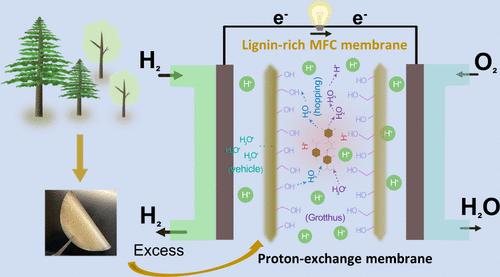Lignin-Rich Microfibrillated Cellulose: A Sustainable Alternative for Proton Exchange Membranes for Energy Applications
IF 7.3
1区 化学
Q1 CHEMISTRY, MULTIDISCIPLINARY
引用次数: 0
Abstract
Biobased alternatives to synthetic perfluorinated proton exchange membranes (PEMs) are needed to advance sustainable energy systems. This study evaluates lignin-containing microfibrillated cellulose (LMFC) as a material for PEMs. We produced LMFC from unbleached softwood and hardwood kraft pulps containing 11% and 14% klason lignin, respectively. Compared to lignin-free microfibrillated cellulose (MFC) membrane, LMFC membranes showed enhanced mechanical properties and proton conductivity due to its retained lignin content. The presence of carboxyl groups in LMFC led to doubled proton conductivity versus MFC under varied temperatures and high humidity conditions. While conventional PEMs show significant conductivity loss above 80 °C due to dehydration, both MFC and LMFC membranes demonstrated increasing proton conductivity at temperatures up to 120 °C under high humidity conditions. LMFC membranes exhibited tensile strength above 220 MPa with Young’s modulus exceeding 12 GPa. Gas transport tests revealed high selectivity for H2/N2 and H2/O2 pairs in LMFC and MFC membranes (α(H2/N2) ≈ 210), essential for preventing fuel loss in practical PEM applications. The achieved property ranges convincingly demonstrate LMFC’s potential as a sustainable alternative to conventional PEM materials.

富含木质素的微纤化纤维素:用于能源应用的质子交换膜的可持续替代品
生物基替代品的合成全氟质子交换膜(PEMs)需要推进可持续能源系统。本研究评价了含木质素的微纤化纤维素(LMFC)作为PEMs材料的性能。我们用未漂白的软木和硬木硫酸盐纸浆分别含有11%和14%的木质素制备了LMFC。与不含木质素的微纤化纤维素(MFC)膜相比,LMFC膜由于保留了木质素含量而表现出更高的力学性能和质子导电性。在不同温度和高湿条件下,LMFC中羧基的存在导致其质子电导率比MFC高一倍。传统的PEMs在80°C以上由于脱水会导致导电性损失,而MFC和LMFC膜在高达120°C的高湿条件下都能提高质子导电性。LMFC膜的抗拉强度在220 MPa以上,杨氏模量超过12 GPa。气体输运测试表明,LMFC和MFC膜中H2/N2和H2/O2对具有高选择性(α(H2/N2)≈210),这对于防止PEM实际应用中的燃料损失至关重要。所获得的性能范围令人信服地证明了LMFC作为传统PEM材料的可持续替代品的潜力。
本文章由计算机程序翻译,如有差异,请以英文原文为准。
求助全文
约1分钟内获得全文
求助全文
来源期刊

ACS Sustainable Chemistry & Engineering
CHEMISTRY, MULTIDISCIPLINARY-ENGINEERING, CHEMICAL
CiteScore
13.80
自引率
4.80%
发文量
1470
审稿时长
1.7 months
期刊介绍:
ACS Sustainable Chemistry & Engineering is a prestigious weekly peer-reviewed scientific journal published by the American Chemical Society. Dedicated to advancing the principles of green chemistry and green engineering, it covers a wide array of research topics including green chemistry, green engineering, biomass, alternative energy, and life cycle assessment.
The journal welcomes submissions in various formats, including Letters, Articles, Features, and Perspectives (Reviews), that address the challenges of sustainability in the chemical enterprise and contribute to the advancement of sustainable practices. Join us in shaping the future of sustainable chemistry and engineering.
 求助内容:
求助内容: 应助结果提醒方式:
应助结果提醒方式:


